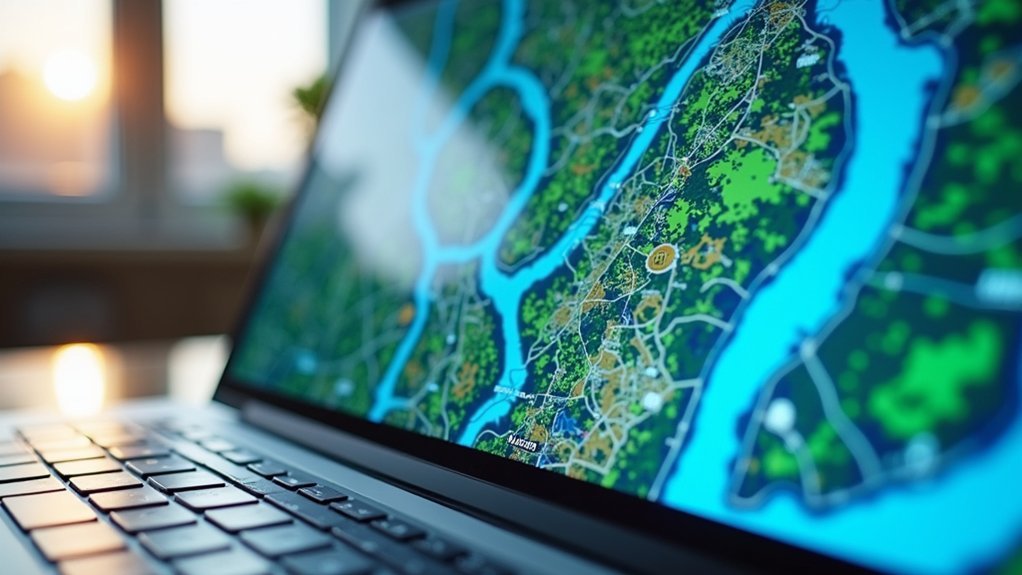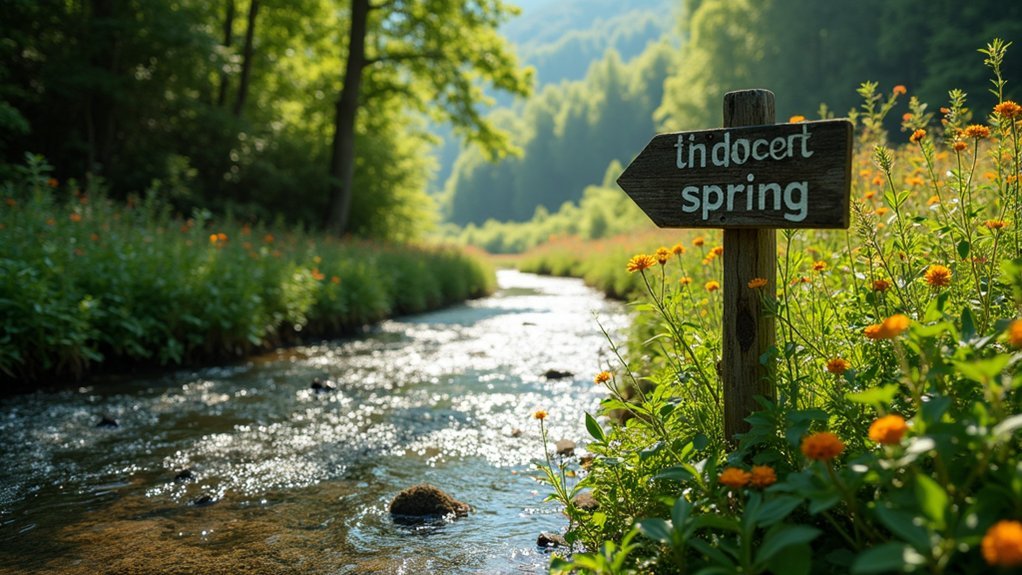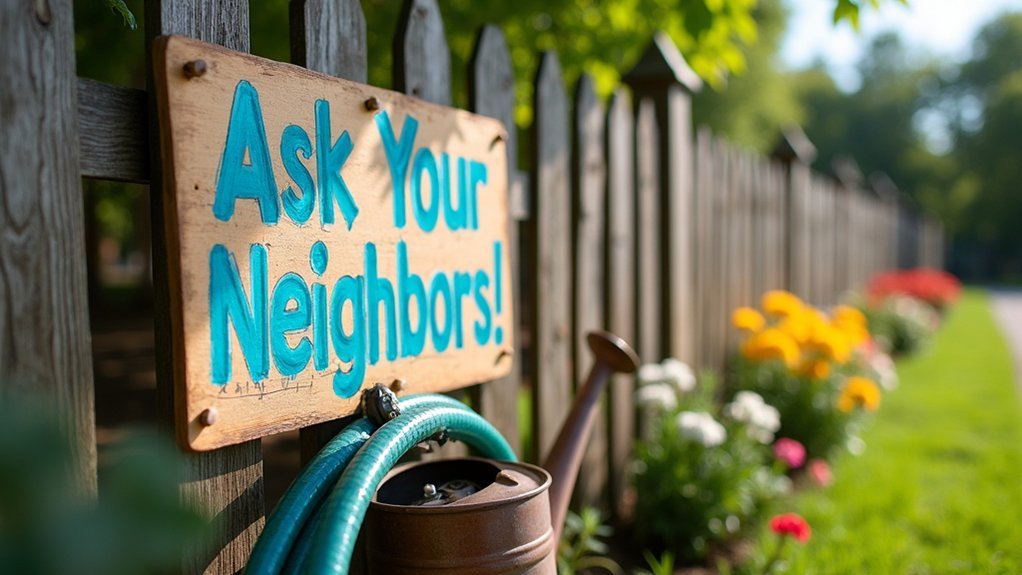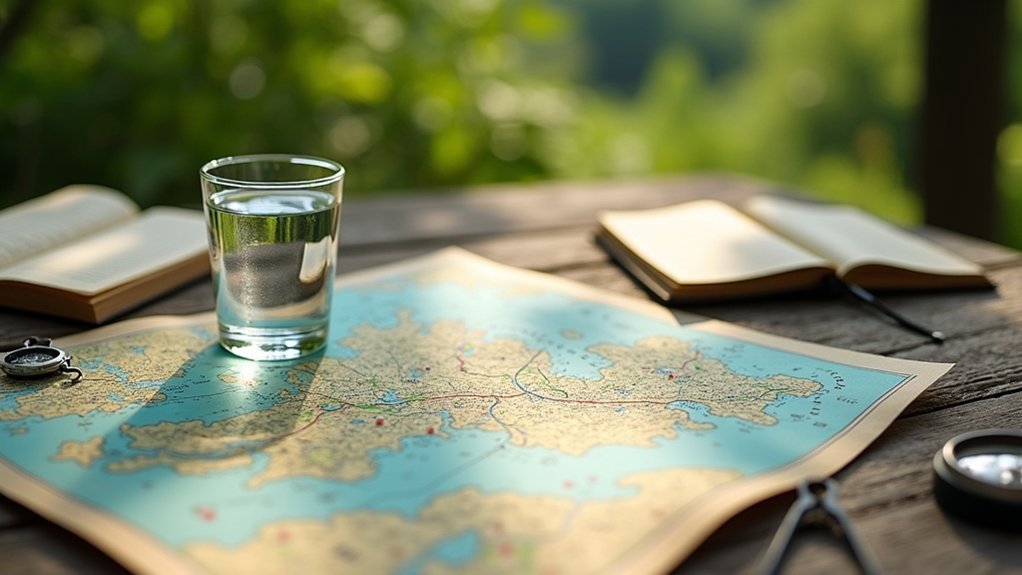To find your local water source, check your water bill first for provider details. Use online water authority maps or the EWG's Tap Water Database for thorough information. Contact your Municipal Utility District directly or consult Consumer Confidence Reports for quality data. Ask neighbors about their service, review property records, or attend community water board meetings. Your county's property appraisal website often contains utility connection information. Discover more ways to understand exactly where your tap water originates below.
10 Ways to Find Your Local Water Source

Where exactly does your tap water come from? If you're wondering about your Houston drinking water source, the WHCRWA map application makes it easy to find answers.
Simply enter your address in the search box to identify your specific utility district provider. The interactive map lets you click on different MUD names or color-coded areas to access detailed information about operators and available services.
Remember to verify if your location falls within WHCRWA boundaries, as not all addresses receive service from this authority.
For information about water fees, check your district's water bills where WHCRWA charges are typically included.
You can also access groundwater reduction plans and learn about construction projects affecting your water supply through the West Harris County Regional Water Authority's resources.
Check Your Water Bill for Provider Information
While interactive maps offer one method of identifying your water source, the simplest approach might be sitting in your mail pile right now. Your water bill contains valuable information about where your tap water comes from.
Look for the water utility provider name prominently displayed on your statement. This identifies exactly who supplies your water. The bill typically includes customer service contact information, making it easy to call with questions about water quality or source details.
You'll also find if you're served by a Municipal Utility District (MUD), which manages its own water supply. Pay attention to listed fees, as they can help you understand your specific rate structure.
Check your water bill regularly, as provider information and rates may change over time.
Use Online Water Authority Maps and Databases

If you've misplaced your water bill, online water authority maps provide a convenient alternative for identifying your water source. Maps like those from WHCRWA feature user-friendly search functions where you can enter your address to locate your specific water utility provider and relevant Municipal Utility Districts (MUDs).
These interactive tools offer zoom controls that let you navigate through neighborhoods and access detailed information with a simple click on MUD names or color-coded areas.
You'll find valuable data about your service operators, websites, groundwater reduction plans, and ongoing construction projects.
Contact Your Local Municipal Utility District (MUD)
Municipal Utility Districts (MUDs) offer direct communication channels for obtaining detailed information about your water source.
These specialized districts manage water services in specific Texas areas, providing essential information about your reliable water supply.
- Contact your MUD operator directly with questions specific to your address
- Verify if your property falls within a MUD's boundaries, as this affects your water service
- Access thorough water quality reports through your district representative
- Use the WHCRWA map application to find your MUD's contact information
- Inquire about billing procedures and service issues through your district office
Consult Environmental Working Group's Tap Water Database

The Environmental Working Group's Tap Water Database offers thorough coverage of water quality across the United States, making it a valuable resource for concerned citizens.
You can easily search for your specific water provider by entering your ZIP code or water utility name into the database's search function.
Once you've located your provider, you'll gain access to detailed information about contaminants, testing results, and how your water compares to national standards.
EWG's Comprehensive Coverage
Steering through the complexities of local water quality becomes considerably easier when you consult the Environmental Working Group's Tap Water Database.
This extensive resource covers over 50,000 water systems nationwide, including Houston's tap water quality and specific contaminants present in your area.
To access this wealth of information:
- Enter your zip code or water system name in the search box
- Review detailed reports on contaminants found in your local tap water
- Compare your water quality against national standards and other systems
- Understand potential health risks associated with identified pollutants
- Discover ways to engage with local water issues and advocate for improvements
This powerful tool empowers you to make informed decisions about your drinking water while promoting greater environmental awareness in your community.
Locating Your Provider
Wondering how to identify exactly which utility supplies your home's water? The Environmental Working Group (EWG) Tap Water Database makes this process simple. You'll gain access to detailed information about your drinking water system by entering your location into their user-friendly search interface.
| Feature | Benefit | Action |
|---|---|---|
| Location Search | Identifies your specific water providers | Enter your address or ZIP code |
| Contaminant Reports | Details pollutants and health risks | Review your water quality assessment |
| Comparison Tools | Shows how your water compares to others | Evaluate alternative water sources |
This powerful tool not only reveals what's in your tap water but also highlights potential concerns. By using the EWG database, you'll better understand your water quality and can take informed steps toward safer drinking water.
Visit Your City or County Website's Utilities Section
Your city or county website's utilities section offers a wealth of information about your local water source through navigable provider pages and interactive maps.
Check these online resources to identify your specific municipal utility district, water provider, and service area boundaries.
If you can't find what you're looking for, contact your municipal services department directly for personalized assistance regarding your water supply.
Navigate Utility Provider Pages
The official city or county website serves as a gateway to discovering your local water source information.
Once you've located the utilities section, you'll find thorough details about your local water provider and services.
- Look for interactive maps that pinpoint your specific water utility provider by entering your address.
- Access water quality reports showing safety testing and compliance with health standards.
- Find contact information for your local water provider to report issues or ask questions.
- Discover community resources like conservation programs and emergency notification systems.
- Use the website's search function to locate specific topics such as groundwater reduction plans.
These resources help you understand where your water comes from, its quality, and who's responsible for delivering this essential service to your home.
Check Interactive Water Maps
Interactive water maps represent one of the most valuable tools available on city and county websites. You'll find these user-friendly resources in the utilities section, allowing you to pinpoint your local water source by simply entering your address.
| Feature | Benefit | Access Method |
|---|---|---|
| Address Search | Identifies your specific water service providers | Enter your home address |
| District Information | Shows MUDs and operator details | Click on district names |
| Jurisdiction Verification | Confirms if you're in WHCRWA territory | Zoom into neighborhood |
These maps provide essential links to water authority websites and help explain fees appearing on your bill. By utilizing these interactive water maps, you'll gain valuable insight into your area's groundwater reduction plans and available utilities. This understanding proves vital for homeowners seeking thorough information about their local water infrastructure.
Contact Municipal Services Department
When seeking detailed information about your local water source, contacting the Municipal Services Department (MSD) offers a direct approach to obtaining accurate details.
Your city or county's website typically features a dedicated Utilities section where you'll find extensive information about your water supply.
- Visit your local government's official website and navigate to the Utilities section
- Look for Municipal Services Department listings that detail water providers in your area
- Access water quality reports and consumer confidence documents specific to your location
- Find contact information for municipal utility districts (MUDs) serving your neighborhood
- Review information about ongoing water management projects that might affect your service
This resource guarantees you're informed about local water management and can easily connect with the appropriate authorities regarding your water supply.
Review Consumer Confidence Reports (CCRs)
A thorough look at your local drinking water quality is available through Consumer Confidence Reports (CCRs).
These annual documents, required by the Safe Drinking Water Act, provide detailed information about your drinking water's source and any contaminants detected in relation to regulatory standards.
Consumer Confidence Reports deliver essential insights about water sources and contaminants as mandated by federal drinking water regulations.
You'll find valuable insights about whether your water comes from surface or groundwater sources, along with potential health effects associated with any contaminants.
Most water utilities now publish their CCRs online, making it simple for you to access this critical information.
Ask Neighbors About Their Water Service Provider

While Consumer Confidence Reports provide official data about your water supply, your neighbors can offer valuable first-hand insights that complement these documents.
Reaching out to those living nearby can help you gather practical information about your local water utility.
- Ask neighbors about their experiences with water quality and if they've noticed any issues.
- Inquire about billing practices, rates, and customer service responsiveness.
- Determine if your specific address is served by the same water utility as surrounding homes.
- Learn about upcoming infrastructure changes or rate adjustments that might affect service.
- Use these conversations to build community connections for addressing shared water concerns.
This neighborhood knowledge often reveals practical details about service reliability that official reports mightn't capture, helping you better understand your water source.
Search Property Records for Utility Information
Property records represent one of the most reliable sources for identifying your water service provider. These documents typically contain detailed information about all utility providers connected to your address, including specific water service details.
You can access these records through your county's property appraisal district website, where public databases allow you to search by address or owner name. Simply enter your property information to reveal water utility connections and any municipal utility districts (MUDs) associated with your location.
Don't overlook your existing utility bills, which often indicate your water service provider and related fees.
If you need additional clarification, local government offices and utility management companies can provide further information about water service connections specific to your property. These resources guarantee you'll accurately identify your local water source.
Attend Local Community Water Board Meetings

Beyond searching property records, attending local water board meetings offers invaluable insight into your community's water source.
These gatherings provide direct access to officials who manage your water supply and can answer specific questions about water quality and service fees.
- Learn about your area's water sources and treatment processes
- Engage directly with local water authority representatives
- Voice concerns regarding water quality or upcoming projects
- Understand specific fees appearing on your water bills
- Stay informed about future water management initiatives
You'll find meeting schedules and agendas on your local water authority's website.
Organizations like Municipal Utility Districts (MUDs) and regional authorities, such as the West Harris County Regional Water Authority, regularly host these public meetings.
Frequently Asked Questions
How Can I Find Out Where My Water Comes From?
You can find your water source by checking the EWG Tap Water Database, reviewing your local Consumer Confidence Report, or contacting your utility provider. Houston's water comes primarily from rivers and aquifers.
How Do I Find a Water Source on My Property?
To find a water source on your property, use the WHCRWA map app by entering your address. You'll identify your utility provider or MUD, or contact the Harris Galveston Subsidence District for groundwater information.
How Do You Find Your Local Water Supplier?
You can find your local water supplier by using the WHCRWA map application. Enter your address in the search box, and it'll identify your utility provider, showing detailed information when you click on districts.
How Do You Find Water Sources?
You can find water sources by consulting geological surveys, topographic maps, and local environmental agencies. You'll also discover natural springs, lakes, and rivers by exploring watersheds or using satellite imagery resources.
In Summary
You've got multiple resources at your fingertips to identify your local water source. Whether you're checking your bill, exploring online databases, or connecting with neighbors, understanding where your water comes from empowers you to make informed decisions. Take advantage of these tools to stay informed about your water quality and provider. It's your right to know what's flowing from your tap.





Leave a Reply